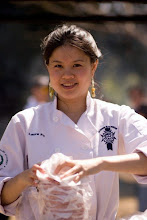Traditionally, Panzanella was made with bread, tomatoes, olive oil, and flavored with basil and salt & pepper. Leftover ingredients were commonly thrown into the salad, making it somewhat of a peasant dish when there was not a lot of surplus. Same idea here, I thought I would stick to the bread, tomatoes & basil, but instead of using only bread as a base, I sliced some thick chiffonade (ribbons) of Basil to bulk the salad up, and it made for a really interesting lettuce stand in.
I also remember that when I staged at Jardinaire, we served a similar (more rustic) bread salad, with a farmer's cheese that was soft & chewy, marinated in olive oil and balsamic - integrating some great texture into the salad. I wanted to replicate that as well, and chose to use Burrata, a fresh Italian cheese similar to buffalo mozzarella, but with cream on the inside. You could also use Buffalo Mozzerella, but I liked the creamy insides that soaked into the crunchy bread, preventing it from becoming too dry.
Another twist on the salad included it being served warm, instead of cold (reserved for summer nights), and I did this my roasting the tomatoes in a pan, which also gave me the opportunity to infuse flavor into the salad by warming garlic slices. It's an absolute winner for lite bites at night!

Here's the recipe!
Panzanella
Serves 2
5 slices Good thick Bread, cut into 1/4" cubes
2 Tbs Olive Oil
Salt & pepper to taste
Preheat the oven to 400F. Season bread well with salt & pepper and toss with olive oil. Bake in a single layer in the oven for about 10 minutes, or until golden brown
1 cup Cherry or Grape tomatoes, halved
5 ea Garlic Cloves, sliced thin
2 Tbs Olive Oil
While the bread is baking, heat the oil in a saute pan. Add the garlic cloves and gently cook until slices start to soften, but not brown. Increase heat to high and add tomato halves. Roaste tomatoes until skin starts to brown. Remove from heat
2 cup Loosely packed Basil Leaves from thick stalks, chopped into 1/8" ribbons
2 balls Burrata or Buffalo Mozzerella balls, halved, then sliced into rings
Toss the bread, warm tomatoes & garlic mixture, basil and cheese together. Serve immediately and with a sprinkling of freshly ground pepper.


